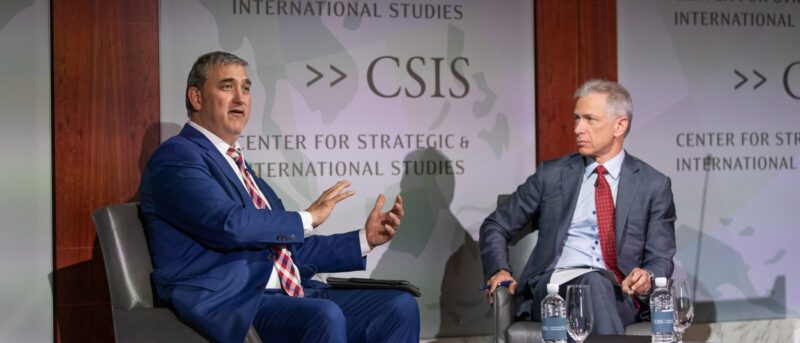Dr. Kirti Gupta – Testimony: Innovating Ideas Around Standards and Intellectual Property

On September 20th, 2023, LeadershIP Executive Director Dr. Kirti Gupta testified for the ITA-NIST-USPTO Listening Session on Innovating Ideas Around Standards and Intellectual Property.
Transcript: Good afternoon. My name is Dr. Kirti Gupta and I am speaking on behalf of the Center for Strategic and International Studies (CSIS).
Let me start by thanking the agencies for organizing hearings on this important topic at the intersection of technology standards and intellectual property. Standards have been an esoteric topic, and perhaps still are. But state leaders around the world have now recognized the importance of standards for critical and emerging technologies.
To introduce myself, I have worked as an engineer for wireless communication standards, attended numerous standards meetings including the third-generation partnership project (“3GPP”), and filed patents in the field during my tenure at Qualcomm as a wireless systems engineer. Later, I served as Qualcomm’s Chief Economist and have led and published economic analysis in the field of standards and intellectual property.
I’ll start by briefly addressing what standards are and why they matter. While there are thousands of standards, from measurement, and weight, to the thickness of pencils – where the critical feature is interoperability, that is, having a consistent set of rules or speaking a common language, we’re here to discuss another type of standards – for critical and emerging technologies. Here, interoperability is still key, but the defining feature is innovation. Innovative solutions for new technical cutting-edge problems that the industry is facing and voluntarily cooperating to solve together.
1. Technology leadership in critical and emerging technology standards are a priority for national security. Governments around the world have recognized the importance of technology standards. China has a “2035 Standards Plan”. The EU published its “Standardization Strategy” in 2022. The US published its “National Standards Strategy” in May of this year.
2. U.S. must protect incentives to invest in standards R&D for maintaining its technology leadership.
- Technology Standards in Critical and Emerging technologies require significant investments from private organizations that voluntarily participate in standards bodies. Technologies such as 5G are highly complex requiring teams of highly skilled engineers for firms to have meaningful R&D programs and presence in international standards bodies. One of the main reasons these firms invest in R&D and participate in standards is due to their ability to license their Intellectual Property and recoup their investments.
- Without strong enforcement of IP rights in any jurisdiction – US or foreign – the firms investing in R&D for standards may have difficulty licensing their IP rights and are likely to have reduced incentives to innovate in these technologies.
- Currently, the European Commission (EC) is considering a legislative proposal seeking to address what some have perceived as lack of transparency and predictability in the licensing of SEPs. The EC’s draft SEP legislation, among other things, seeks to establish an out-of-court procedure to determine licensing conditions and aggregate royalty rates for a given standard. Any such proposal that seeks to regulate licensing rates reduces the incentives to innovate for firms investing in these standards.
3. Current U.S. IP law or policy on FRAND supports U.S. innovation and global competitiveness in standards.
- The market-based approach for the determination of FRAND rates has delivered a highly successful industry over the last several decades. There are more mobile subscriptions today than the number of people on the planet. Mobile technology is perhaps the most democratically adopted technology on the planet.
- There is now a robust body of case law on FRAND jurisprudence across the globe in major jurisdictions providing clarity on key FRAND principles.
- The US policy makers have decided to leave the functioning of licensing to the markets. In early 2022, the US Department of Justice (“DOJ”) circulated a draft policy statement concerning licensing negotiations and remedies for SEPs, later withdrawing not only the idea of issuing a new policy statement, but also the one that was in-place from 2019. Instead, the DOJ committed to focus on evaluating conduct related to SEP licensing on a case-by-case basis. That is the similar approach that the EU has adopted, thus-far.
- Ideally, the US policy makers continue to engage in a bilateral dialogue with the EU to stay in alignment. The EU’s current proposal of regulating the licensing and pricing of SEPs comes at a time when the world is competing for leadership in critical technologies such as 5G standards; indeed, 5G SEPs are a primary focus of this legislation. Regulating 5G licensing framework is likely to have an impact on incentives to innovate and lead in 5G (and future 6G and other critical standards) by the European innovators and beyond. Losing leadership in 5G, 6G, and related technologies has significant geopolitical consequences.
4. The Department of Commerce can strengthen US participation in international technology standards by taking initiatives to maintain a rules-based standards ecosystem. I list some suggested specific policy actions for U.S. policymakers to consider, with the objectives to preserve a rules-based global standards ecosystem, adhering to and maintain a market- and consumer-driven innovation agenda, and technology selection based on consensus and merit.
- Maintain a strong IPR regime. To maintain the incentives of U.S. firms to participate in long-term and risky R&D that is required to be an innovation leader and lead in critical standards, protecting the ability of U.S. firms to monetize their IP in international markets is the first step. A stronger IP regime in the U.S. is also helpful towards increasing the incentives to innovate in patent-intensive critical technologies.
- Establish strong governance principles in SDOs based on openness, transparency, consensus, and majority voting will avoid gamesmanship and maintain a rules-based merit-driven ecosystem.
- Maintain global standards both for U.S. firms to maintain a market-driven incentive in investing in standards (due to an economy of scale that would be lost in a bifurcated world where firms are forced to work only on national standards) and for the world to have the best technologies (due to the innovation agenda being set based on the market and not based on a state’s direction).
- Investing in standards-based skill sets for U.S. workers. The United States, via the National Institute of Standards and Technology (NIST), currently provides limited funding for standards education and curriculum advancement in the United States. The United States’ global competitors invest substantially in this capacity.

Generic Drugs, Property Rights, and the Orange Book

